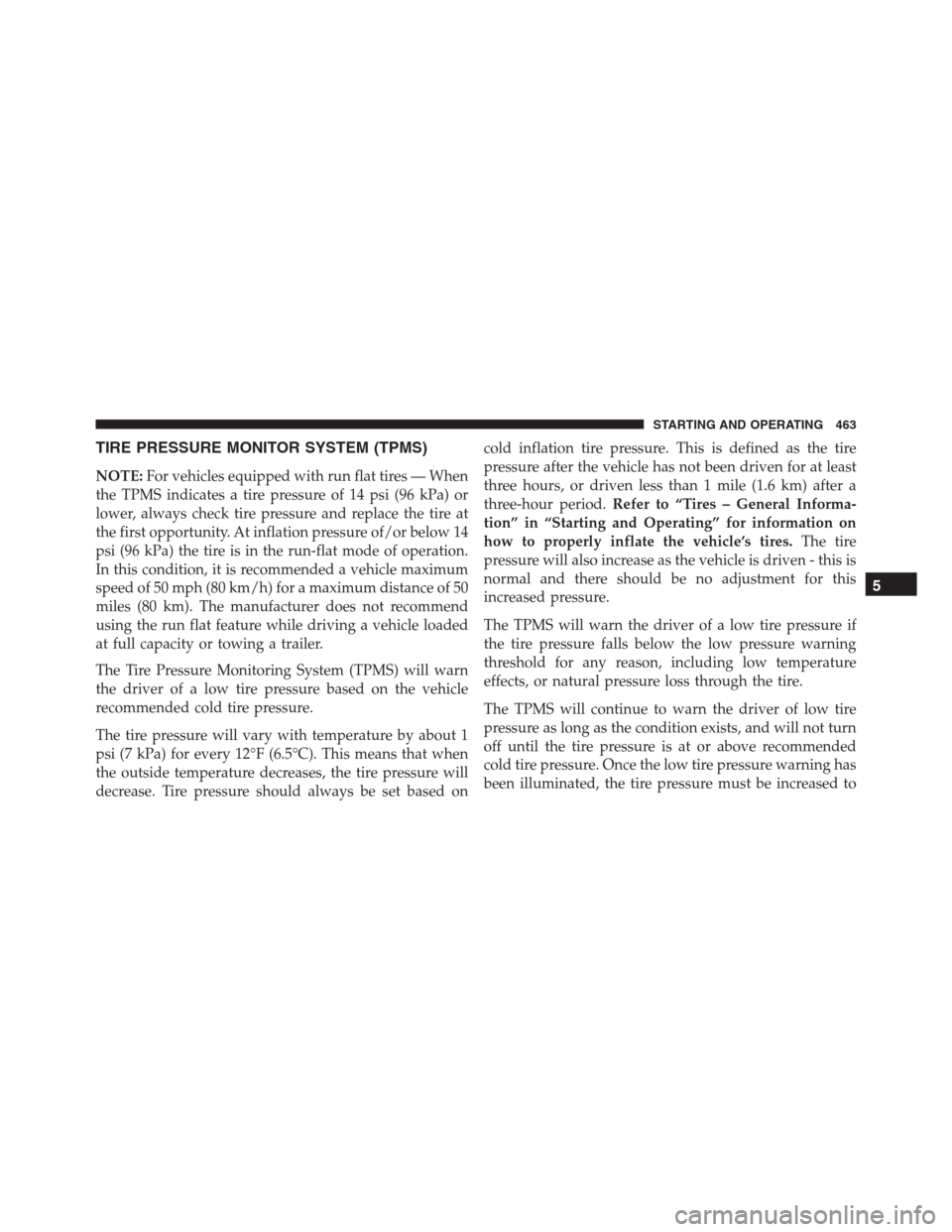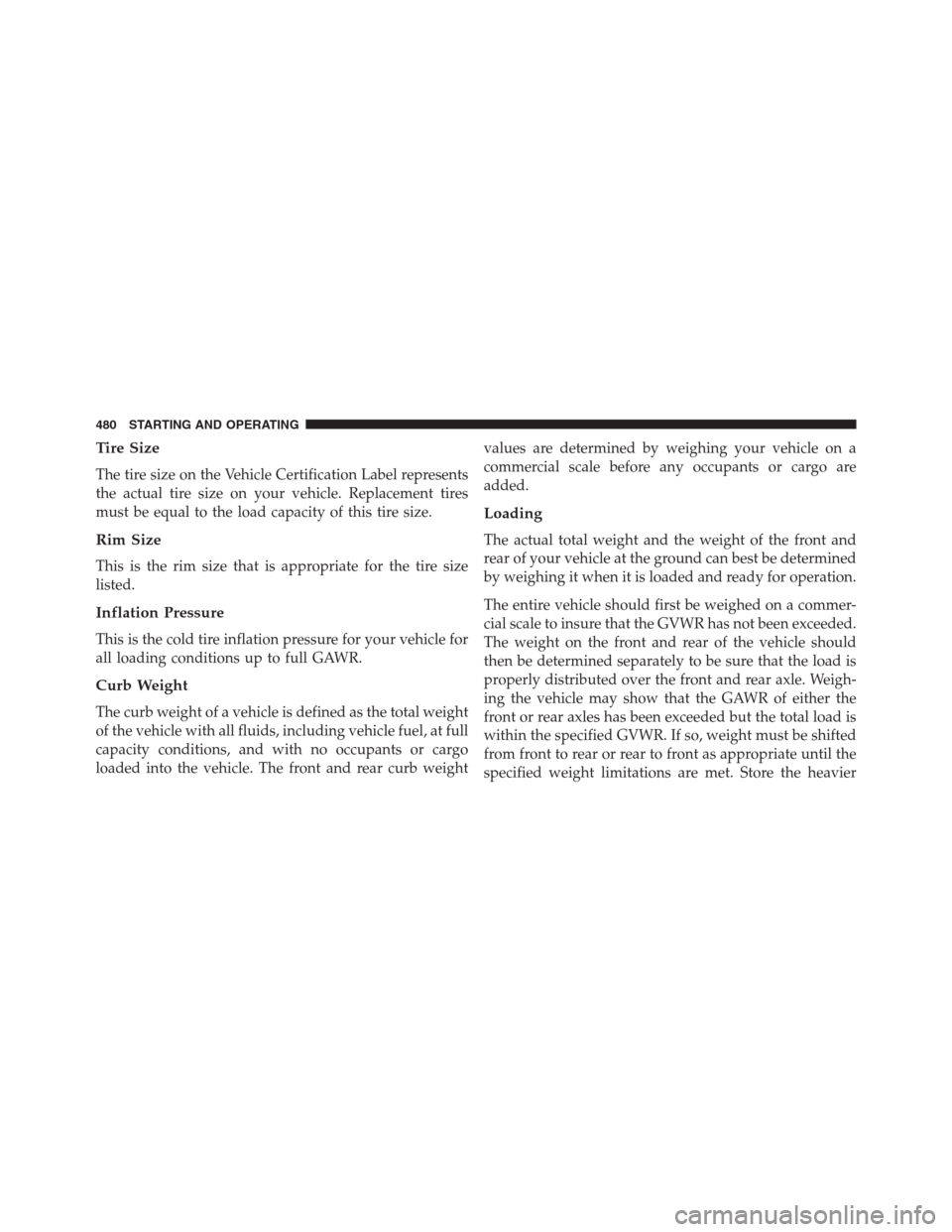Page 465 of 636

TIRE PRESSURE MONITOR SYSTEM (TPMS)
NOTE:For vehicles equipped with run flat tires — When
the TPMS indicates a tire pressure of 14 psi (96 kPa) or
lower, always check tire pressure and replace the tire at
the first opportunity. At inflation pressure of/or below 14
psi (96 kPa) the tire is in the run-flat mode of operation.
In this condition, it is recommended a vehicle maximum
speed of 50 mph (80 km/h) for a maximum distance of 50
miles (80 km). The manufacturer does not recommend
using the run flat feature while driving a vehicle loaded
at full capacity or towing a trailer.
The Tire Pressure Monitoring System (TPMS) will warn
the driver of a low tire pressure based on the vehicle
recommended cold tire pressure.
The tire pressure will vary with temperature by about 1
psi (7 kPa) for every 12°F (6.5°C). This means that when
the outside temperature decreases, the tire pressure will
decrease. Tire pressure should always be set based oncold inflation tire pressure. This is defined as the tire
pressure after the vehicle has not been driven for at least
three hours, or driven less than 1 mile (1.6 km) after a
three-hour period.Refer to “Tires – General Informa-
tion” in “Starting and Operating” for information on
how to properly inflate the vehicle’s tires.The tire
pressure will also increase as the vehicle is driven - this is
normal and there should be no adjustment for this
increased pressure.
The TPMS will warn the driver of a low tire pressure if
the tire pressure falls below the low pressure warning
threshold for any reason, including low temperature
effects, or natural pressure loss through the tire.
The TPMS will continue to warn the driver of low tire
pressure as long as the condition exists, and will not turn
off until the tire pressure is at or above recommended
cold tire pressure. Once the low tire pressure warning has
been illuminated, the tire pressure must be increased to
5
STARTING AND OPERATING 463
Page 467 of 636

CAUTION!(Continued)
cause the Tire Pressure Monitoring System (TPMS)
sensor to become inoperable. After using an after-
market tire sealant it is recommended that you take
your vehicle to an authorized dealership to have
your sensor function checked.
•After inspecting or adjusting the tire pressure,
always reinstall the valve stem cap. This will
prevent moisture and dirt from entering the valve
stem, which could damage the Tire Pressure Moni-
toring Sensor.
NOTE:
•The TPMS is not intended to replace normal tire care
and maintenance, or to provide warning of a tire
failure or condition.
•The TPMS should not be used as a tire pressure gauge
while adjusting your tire pressure.•Driving on a significantly under-inflated tire causes
the tire to overheat and can lead to tire failure.
Under-inflation also reduces fuel efficiency and tire
tread life, and may affect the vehicle’s handling and
stopping ability.
•The TPMS is not a substitute for proper tire mainte-
nance, and it is the driver ’s responsibility to maintain
correct tire pressure using an accurate tire gauge, even
if under-inflation has not reached the level to trigger
illumination of the Tire Pressure Monitoring Telltale
Light.
•Seasonal temperature changes will affect tire pressure,
and the TPMS will monitor the actual tire pressure in
the tire.
Premium System
The Tire Pressure Monitor System (TPMS) uses wireless
technology with wheel rim-mounted electronic sensors to
5
STARTING AND OPERATING 465
Page 482 of 636

Tire Size
The tire size on the Vehicle Certification Label represents
the actual tire size on your vehicle. Replacement tires
must be equal to the load capacity of this tire size.
Rim Size
This is the rim size that is appropriate for the tire size
listed.
Inflation Pressure
This is the cold tire inflation pressure for your vehicle for
all loading conditions up to full GAWR.
Curb Weight
The curb weight of a vehicle is defined as the total weight
of the vehicle with all fluids, including vehicle fuel, at full
capacity conditions, and with no occupants or cargo
loaded into the vehicle. The front and rear curb weightvalues are determined by weighing your vehicle on a
commercial scale before any occupants or cargo are
added.
Loading
The actual total weight and the weight of the front and
rear of your vehicle at the ground can best be determined
by weighing it when it is loaded and ready for operation.
The entire vehicle should first be weighed on a commer-
cial scale to insure that the GVWR has not been exceeded.
The weight on the front and rear of the vehicle should
then be determined separately to be sure that the load is
properly distributed over the front and rear axle. Weigh-
ing the vehicle may show that the GAWR of either the
front or rear axles has been exceeded but the total load is
within the specified GVWR. If so, weight must be shifted
from front to rear or rear to front as appropriate until the
specified weight limitations are met. Store the heavier
480 STARTING AND OPERATING
Page 497 of 636

•Trailer brakes are recommended for trailers over
1,000 lbs (454 kg) and required for trailers in excess of
1,653 lbs (750 kg).
Towing Requirements — Tires
•Proper tire inflation pressures are essential to the safe
and satisfactory operation of your vehicle. Refer to
“Tires – General Information” in “Starting And Oper-
ating” for proper tire inflation procedures.
•Check the trailer tires for proper tire inflation pres-
sures before trailer usage.
•Check for signs of tire wear or visible tire damage
before towing a trailer. Refer to “Tires – General
Information” in “Starting And Operating” for proper
inspection procedure.
•When replacing tires, refer to “Tires – General Infor-
mation” in “Starting And Operating” for proper tirereplacement procedures. Replacing tires with a higher
load carrying capacity will not increase the vehicle’s
GVWR and GAWR limits.
Towing Tips
NOTE:To provide optimum towing performance and to
protect transmission components always select TOW
mode when towing a trailer. Before setting out on a trip,
practice turning, stopping and backing the trailer in an
area away from heavy traffic.
Automatic Transmission
The DRIVE range can be selected when towing. The
transmission controls include a drive strategy to avoid
frequent shifting when towing. However, if frequent
shifting does occur while in DRIVE, select TOW mode, or
use the Paddle Shift switches to manually select a lower
gear.
5
STARTING AND OPERATING 495
Page 632 of 636

Tires.........................111,448, 454, 611
Aging (Life Of Tires).....................458
Air Pressure...........................448
Chains...............................460
Compact Spare.........................455
General Information..................448, 454
High Speed...........................451
Inflation Pressures.......................449
Life Of Tires...........................458
Load Capacity......................443, 444
Pressure Monitor System (TPMS)............463
Pressure Warning Light...................286
Quality Grading........................611
Radial...............................451
Replacement...........................458
Rotation..............................461
Safety............................436, 448
Sizes................................437
Snow Tires............................453Spare Tire......................454, 456, 505
Spinning.............................457
Tread Wear Indicators....................457
Tire Safety Information.....................436
Tongue Weight/Trailer Weight................489
Towing................................481
Behind A Motorhome....................497
Guide...............................486
Recreational...........................497
Weight...............................486
Towing Vehicle Behind A Motorhome...........497
Traction Control..........................426
Trailer Sway Control (TSC)..................435
Trailer Towing...........................481
Cooling System Tips.....................497
Hitches
..............................485
Minimum Requirements..................490
Trailer And Tongue Weight................489
Wiring...............................492
630 INDEX
Page:
< prev 1-8 9-16 17-24